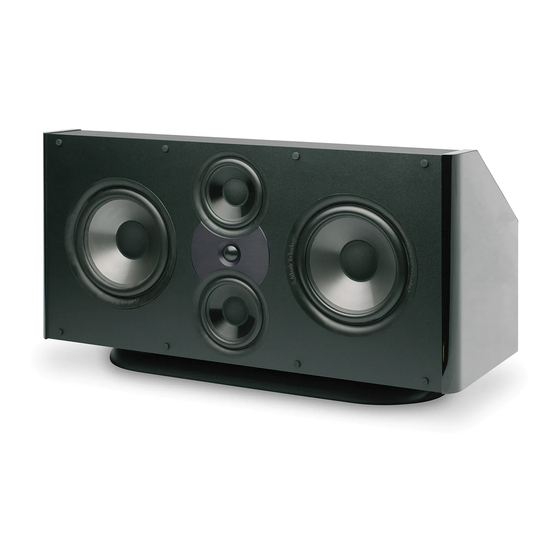Atlantic Technology System 6200 Manuel d'instruction - Page 6
Parcourez en ligne ou téléchargez le pdf Manuel d'instruction pour {nom_de_la_catégorie} Atlantic Technology System 6200. Atlantic Technology System 6200 12 pages. Pedestal subwoofer systems
Également pour Atlantic Technology System 6200 : Manuel d'instruction (20 pages)

6
Connecting Your System
There are dedicated LEFT and RIGHT model 8200 SR and 6200 SR speak-
ers. This is clearly marked on the back of each speaker. Normally, be sure
that the Left side surround speaker is placed directly to the left side of the
prime listening area (facing the screen) and the Right speaker is directly to
the right side.As an easy reference,the Dipole/Bipole switch should always
be facing the back of the room.Should you wish to hang them on the wall,
closer than 24 inches to the ceiling, you should remove and re-install the
keyhole hangers upside down.Then turn the speakers over, hanging them
upside down,and swap them side to side for proper operation.
6.1/7.1 Channel Systems
If you are setting up a system that uses back surround speaker(s) as well as
side surrounds (Dolby Digital EX,DTS ES,etc.) you can choose to use either
SR model speakers in Dipole or Bipole mode or another pair of front LR
speakers in the back of the room.You can also choose to use the 6200 LR in
place of the 8200 LR for the back surround channels,with some compromise
in ultimate output levels and absolute system sonic matching.If the 8200 SR
or 6200 SR are used as back surrounds in a 6.1 or 7.1 channel system, they
should be installed with the Right speaker placed over the listeners left shoul-
der and the Left speaker placed over the listeners right shoulder.When used
for 6.1 or 7.1 channel systems the back surrounds should be placed approxi-
mately 150 degrees from the screen on the back wall.About 1/3rd of the way
out from the corners in most rooms is a good starting point.
If you are using a THX Ultra 2 certified controller/receiver you should place
the back surround speakers approximately 1 to 2 feet apart in the center
of the back wall. The special circuitry in the processor will help to create a
believable and effective surround field using this placement.Please read the
electronics manual to learn more about this placement option.
Stereo Systems
If you are setting up a stereo system using a pair of 8200/6200 LRs with
subwoofer(s),begin with these general guidelines:
The distance between the speakers should be approximately one-half
their distance from the prime listening position.
If youpointthefrontof thespeakersdirectlytowardstheprimelistening
position("toe"themin),youwillachievethemostpreciseimagingand
the most direct high frequency sound.If you have a"bright"or"hard"
soundingroom,aimingthespeakersstraightoutintotheroom(orjust
aiming them partially towards you) may make for a more natural and
pleasing sonic balance.
Thedistancefromeachspeakertoitsthreeclosestroomsurfacesshould
be different.
In most rooms,you should not place your speakers in the corners.
The goal is to reproduce accurate musical timbre and natural sound.Addi-
tionally, a well set-up stereo pair of speakers will create excellent imaging
and a cohesive representation of the soundstage.Placement in the room and
your listening position have an enormous impact on the ultimate sound you
will achieve from your system. The most important thing is to be creative!
Try placing your speakers on the long wall instead of the short one.Toe the
speakers in or point them straight ahead. Pull them away from the wall or
push them closer.Don't be timid.You'll find that moving your speakers,even
a few inches,can dramatically change and possibly improve their sound.
Connecting Your System
We recommend that you connect your system using high quality dual
conductor stranded wire of 16 gauge or heavier, for lengths up to 25
feet. (Remember, the lower the gauge number, the heavier the wire). Use
heavier gauge wire for longer runs. Please contact your audio/video dealer
or installer for specific cable recommendations and further information
regarding special circumstances.
Bi-Wiring
There are two identical sets of speaker wire connectors on the back of
each of the three front enclosures. They are there to provide the option of
Bi-Wiring the speakers. Bi-Wiring lets you connect two sets of input wires
(or a specially constructed Bi-Wire cable,see your dealer for further details)
between the power amplifier or receiver and the speaker.This practice has
its roots in high-end audio and it is generally agreed that using two sets of
high quality speaker wires between the speaker and amplifier help to main-
tain the amplifier's control in the bass range (by maintaining the amplifier's
damping factor).It also potentially allows more efficient power transfer by
keeping the total resistance of the speaker wires at a lower level.
HF ENERGY
– REVERBERANT
+ DAMPED ROOM
0 THX / AVERAGE
LOCATION
BEHIND SCREEN
THX / NORMAL
BOUNDARY
COMPENSATION
ON
THX / NORMAL
You can Bi-Wire by connecting two sets of speaker wires from the ampli-
fier terminals to the input terminals on the back of the speaker enclosure.
The wires should be attached to a single output terminal set on the ampli-
fier.The other end is attached to the two sets of input terminals on the rear
panel of the loudspeaker. Some manufactured Bi-Wire cables have only a
single set of connectors at the amplifier end and two sets of connectors at
the speaker end.
You may choose to Bi-Wire the speakers or not. If you do Bi-Wire, remove
the gold jumper links that comes factory installed between the sets of input
terminals (Figure 4). See"SystemWiring Using Bi-Wire Option"on the next
page for an example of Bi-Wiring.
System 8200/System 6200 High Performance Loudspeakers
HF
LF
���� ������
����� ���� ��
������� �� ���
������ �� �������
��� ����� �������
���������
Figure 4
